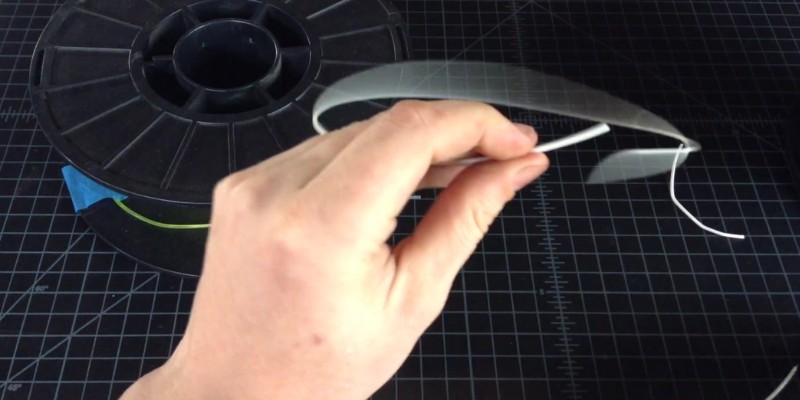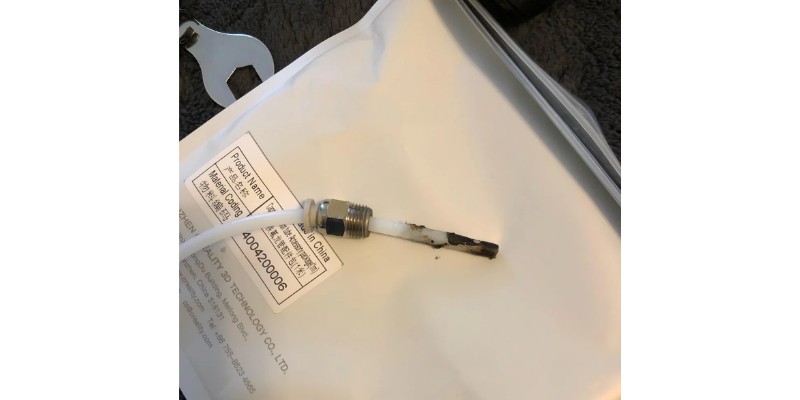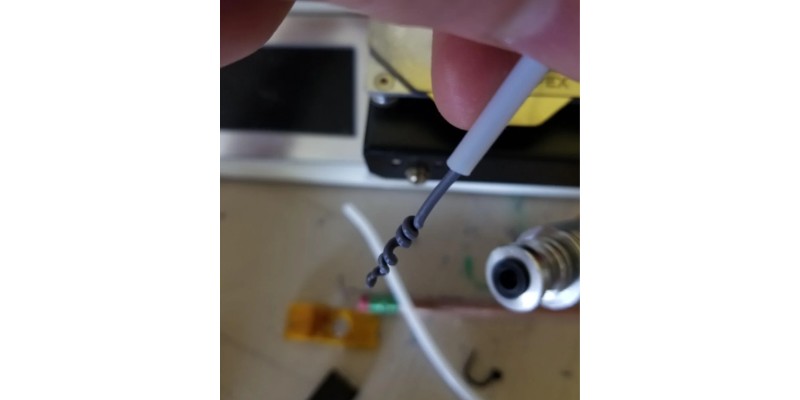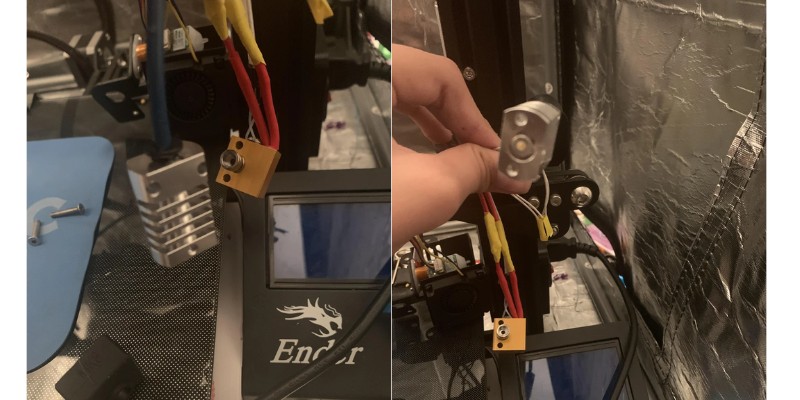
How To Fix Filament Stuck in PTFE Tube (Every Solution)


At 3DSourced we’ve covered everything 3D printing and 3D since 2017. Our team has interviewed the most innovative 3D printing experts, tested and reviewed more than 20 of the most popular 3D printers and 3D scanners to give our honest recommendations, and written more than 500 3D printing guides over the last 5 years.
The PTFE tube is the tube that guides 3D printer filament into the extruder. If filament gets stuck in the PTFE tube, it can lead to frustrating and even serious complications, so it’s important to know not only why this happens, but also how to fix it or even prevent it from happening at all.
Normally, fixing 3D printer filament stuck in this tube is a fairly easy process. If it’s a minor clog, then you’ll find that simply pouring hot water through the PTFE tube will safely flush out stuck filament without harming the PTFE tube itself, which is capable of withstanding much hotter temperatures than boiled water.
However, depending on the filament and how bad the clog is, you may need to resort to more complex methods.
So, I’m going to explain in this article what causes the filament to get stuck in the PTFE tube, how to fix the issue depending on its severity, and how to best avoid it happening again in the future.
- What Causes Filament to Get Stuck in the PTFE Tube?
- How Do You Prevent Filament Getting Stuck in the PTFE Tube?
- Use a High-Quality Filament
- Keep the Tube Clean
- Use the Correct Temperature
- Ensure Proper Tension
- Use a Filament Guide
- Check For Wear and Tear
- How To Remove Filament Stuck to the Outside of the PTFE Hotend?
- How To Remove Filament Stuck to the Inside of the PTFE Hotend?
What Causes Filament to Get Stuck in the PTFE Tube?

The most common cause of PTFE blockage is low-quality or damaged filament. Older or wet filament is more likely to break while it’s being fed through the tube and become lodged. Another common cause is overly aggressive retraction settings.
While retraction is important, having it set too high can cause too much filament to be brought back up through the nozzle, which clogging the PTFE tube.
This is especially common with Bowden extruders, which tend to have longer feeding distances and are more prone to retraction issues.
How Do You Prevent Filament Getting Stuck in the PTFE Tube?
The best way to fix the issue of filament getting stuck in the PTFE tube is to prevent it from happening at all.
Following these guidelines is a good way to lower the risk of running into this and various other problems in the future.
Use a High-Quality Filament
Low-quality or broken filament is far more likely to break and fracture while being fed through the PTFE tube, sticking to the inside of the tube, or feeding incorrectly and becoming stuck to the extruder.
Using high-quality filament from trusted manufacturers and keeping them in good condition by protecting them from direct sunlight, dusty conditions, and airborne moisture will ensure your materials arrive and stay reliable.
If you’re unsure of how to do this, or are worried that your filament has already become too wet, you can check out our guides on how to properly store filament and our recommendations for drying out wet filament.
Not only will this prevent it from getting stuck in the PTFE tube, but will also help you avoid numerous other 3D printing issues like warping, bubbling, and stringing.
Keep the Tube Clean

Just like sink drains, PTFE tubes run the risk of becoming clogged over time, no matter how careful you are. And just like these drains, the best way to stop it from becoming a problem is to keep it clean before any blockages become too much of an issue.
The best way to do this is to use a cleaning tool like a sponge or tissue soaked in hot water and threaded through the PTFE tube. If the clog isn’t particularly severe or you just want to clean it as a regular task, then letting hot water through it will help get rid of any filament particles or dust that could lead to problems down the line.
Just be sure the cleaning material is non-abrasive, as PTFE tubes, while resistant to heat, can still become damaged by rough surfaces.
Use the Correct Temperature
Filament heated at incorrect temperatures also runs the risk of getting stuck in the PTFE tube or extruder.
This happens mostly when the temperature is set too low, as the filament hardens too quickly when cooled and sticks where it’s not supposed to, like in or on the extruder.
When in doubt, always double-check your filament’s temperature settings and make sure you stay within the range. If you’re still having problems, then increase the temperature in 5℃ increments until the filament extrudes smoothly as expected.
Ensure Proper Tension
Tension refers to the ease with which the filament is threaded through the PTFE tube and into the extruder. If there’s any friction or the filament isn’t fed straight, this can cause it to bunch up and clog the tube.
You can ensure proper tension and reduced friction by making sure the filament is fed smoothly through an undamaged PTFE tube that’s also free of debris and other previous blockages. If your PTFE tube has become damaged, leading to problems with tension, then you may need to get a new one.
If this is the case, then we recommend upgrading as well as replacing. Always double-check the heat and damage resistance of your PTFE tube before purchasing a new one, and try to avoid getting it on the cheap.
Use a Filament Guide
Filament guides are add-ons for your 3D printer that help feed the filament into the PTFE tube as smoothly and uniformly as possible to ensure reliable extrusion and printing.
Just like needle threaders, they simplify filament feeding by removing the more precise manual work.
We recommend using a filament dry box that comes with a filament guide to maximize both efficient feeding as well as filament quality to get the best results.
Check For Wear and Tear
3D printer parts wear out over time and become less reliable. This can be as simple as loose screws that need tightening, or parts and pieces needing complete replacement.
PTFE tubes are the same, especially if you’re using particularly abrasive filaments. If it becomes too worn and scratched, then you’d do well to replace it with something stronger, like a Teflon tube.
It’s a good idea to check your 3D printer for wear regularly, even if you aren’t running into issues. This is especially important if you use your 3D printer particularly often.
How To Remove Filament Stuck to the Outside of the PTFE Hotend?

1. Prepare your equipment
- What you need: Pliers, tweezers, a cleaning needle (or similar long, thin device), heat-resistant gloves, a screwdriver, hex drivers, and your 3D printer’s user manual
Gathering the above tools (and the correct sizes) is the first step in removing filament stuck to the outside of the PTFE hotend.
Not all 3D printers will require these tools to remove the PTFE tube for cleaning or reassembly, but they are good to keep handy just in case.
Before moving to step 2, be sure to put on your heat-resistant gloves to avoid any injury from heated parts or cleaning materials.
2. Remove the PTFE tube
Following the guide in your 3D printer’s user manual, open the extruder carriage. This will reveal where the PTFE tube is attached to your printer.
Removing the tube is often as simple as pushing on the connector to loosen the teeth that hold the PTFE tube in place. Though keep your manual handy in case your 3D printer is different.
You may need your screwdriver, depending on how your PTFE tube is attached to the printer.
3. Clear out the stuck filament
Using a vice or similar to hold the PTFE tube in place (even having someone hold it should suffice), feed the cleaning needle through the tube to remove any filament stuck to the inside.
While any thin material will do, using the filament of appropriate width is often the best method to make sure the PTFE tube is cleared thoroughly.
Depending on the severity of the blockage, you may need to heat up what you’re feeding through to help dislodge any stuck filament.
4. Reassemble
Once you’re confident that the tube is clear, reassemble the parts carefully to make sure everything is back where it belongs.
Once complete, run a small test print to make sure everything is where it should be and in good working order.
How To Remove Filament Stuck to the Inside of the PTFE Hotend?

Filament stuck inside the hotend is another issue you may run into, especially if you’re using low-quality or wet filament. Fortunately, you can remove this stuck filament with just a few simple steps.
1. Partially unscrew the nozzle
Unscrewing the nozzle partially loosens the part connecting the hot and cold printer parts, known as the heartbreak. You’ll be able to identify this via the user manual if you’re unsure.
2. Unscrew the heater block from the heartbreak
Unscrewing the heater block from the heartbreak is a simple process that can be done by hand. If it’s too tight, then unscrew the nozzle slightly more to loosen it enough to be done manually.
3. Remove the heartbreak from the heatsink
Once loosened, you can manually unscrew the heatsink from the heartbreak. This can normally be done with your hands, but you may need to use your tools if it’s too tight.
However you go about it, be sure to apply a very delicate touch with this step. The connector between the heatsink and heartbreak is often thin and easily broken, so take care when removing it to avoid further need for repair.
4. Push down the ring on coupling and push PTFE tube down
With the previous parts disconnected from each other, the end of the PTFE tube should be exposed. Pushing it downwards will thread it through and allow easy access for step 5.
5. Pull the tube out the other end
With the other end of the PTFE tube exposed, you can now pull it through and free it completely. You may find that this process itself will dislodge some stuck filament, so try to have a paper towel or similar handy to catch any that falls out.
6. Remove the filament
Once free, use an appropriately wide tool to remove any filament caught within and around the PTFE tube and hot end.
This is also a great opportunity to check over your parts and make sure there’s nothing anywhere else that’s inhibiting smooth filament feeding and printing.
If you’re having trouble removing particularly stubborn blockages, boiling the PTFE tube in clean water will help melt and loosen any stuck filament. Don’t worry about the tube when doing this, they’re designed to withstand higher temperatures than boiling point.
7. Reassemble
Taking care not to damage any parts, refit the PTFE tube and reverse the order seen above to reattach the heatsink, heartbreak, and heater block before screwing the extruder back to be tight.
After double-checking that everything is now clean and back where it should be, run a test print to make sure everything is working efficiently, and you’re done!




















